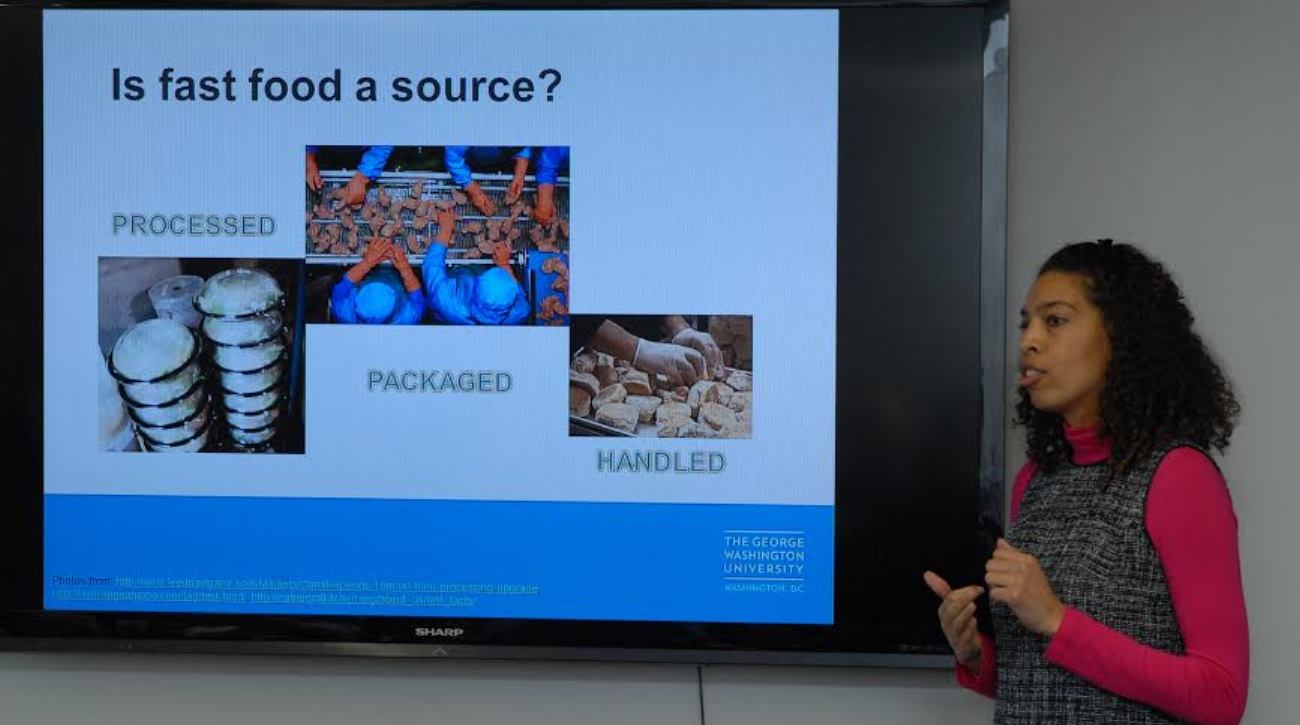Global Environmental Health MPH Alumna Cassie Phillips traveled to Austin, Tex., to give an oral presentation on her culminating experience topic at the recent Children’s Environmental Health Network Research Conference. She credits her research advisor and mentor, Assistant Professor Ami Zota, with encouraging her to submit the abstract about her CE research that the conference’s organizers deemed worthy of an oral presentation.
Phillips’ research project, “Fast Food: A Potential Source of Exposure to Phthalates and Bisphenol A (BPA) Among a Nationally Representative Sample of the US Population,” used data from the U.S. Centers for Disease Control and Prevention’s National Health and Nutrition Examination Survey (NHANES). The analysis that Phillips conducted with Zota linked consumption of fast food with higher levels of two widely used phthalates, DEHP and DINP, as measured in study subjects’ urine.
The experience of presenting her CE to the Environmental and Occupational Health faculty and her peers the month before the conference helped prepare Phillips for describing her project to researchers working in the field, she says — as well as fielding questions about it.
The CE project capitalized on a subset of the NHANES data collection that includes a 24-hour food recall survey. “They ask people very specifically what they ate, where they got it, how much they ate and at what time they ate it,” explains Phillips, who studied public policy as an undergraduate at Duke University.
Phillips initially started her studies at Milken Institute School of Public Health in a different department after she learned about public health and realized that it could be a good fit to marry her analytical skills with her desire to work with people. Once she began taking classes, she found that she was attracted to the Environmental and Occupational Health Department by the sense of community the faculty fosters.
“I wanted to have my graduate school experience be grounded in a good community and good mentorship,” Phillips says. Eventually, she came to realize that her ongoing interest in food related to public health, she says. She made a commitment to action at the Clinton Global Initiative which resulted in securing grant funding to create a community garden in her neighborhood. “I have enjoyed working at the community level through gardening interventions that target healthy eating,” she says.
This ongoing garden project opened up her eyes to a lot of the food justice issues in Washington DC, she explains. Phillips completed her practicum with the DC Department of Health evaluating the Healthy Corner Store program, which tries to increase the amount of fresh fruits and vegetables and other healthy food available in urban “food deserts” by encouraging and helping small retailers to offer healthier food options.
“For my CE, I wanted to do something more quantitative with an eye towards publishing a paper, as a personal goal,” Phillips says. She points out that Dr. Zota has a large portfolio of work and suggested the idea of studying phthalates and BPA linked to fast-food consumption by using NHANES data. “The project represented a reach for me, but in a good way,” Phillips adds. “I cannot say enough positive things about Dr. Zota as my advisor!”
Phillips says she was pleasantly surprised when, in addition to having her abstract accepted, she was asked to give an oral presentation rather than presenting a poster. She says around 25-30 people came to her talk, which was held during one of three concurrent sessions. Phillips thought that it was a wonderful opportunity to leverage the CE to more than just a degree requirement and was thrilled to reach a wider audience at the conference.
Prior to the conference, Dr. Zota and her research associate, Susanna Mitro, collaborated with Phillips to further refine her analysis by food groups because the data was available. “We found that meat was the only food group with a significant association,” she says. “A lot of previous research has documented that diet is a major source of exposure to DEHP and DINP, which is used in food packaging and processing,” she points out.
It’s not exactly clear what aspect of fast food packaging, processing, preparation or handling is the main contributor to the increased phthalates levels linked to fast food consumption of meat, Phillips says. “That is still to be determined.”
Phillips says that she is currently preparing to submit the paper to a journal.


